主动语态变被动语态的几个特例
主动句变被动句的转换规则
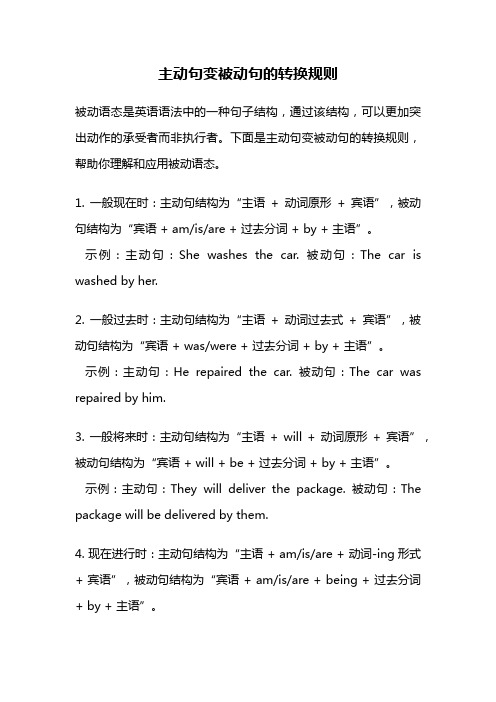
主动句变被动句的转换规则被动语态是英语语法中的一种句子结构,通过该结构,可以更加突出动作的承受者而非执行者。
下面是主动句变被动句的转换规则,帮助你理解和应用被动语态。
1. 一般现在时:主动句结构为“主语+ 动词原形+ 宾语”,被动句结构为“宾语 + am/is/are + 过去分词 + by + 主语”。
示例:主动句:She washes the car. 被动句:The car is washed by her.2. 一般过去时:主动句结构为“主语+ 动词过去式+ 宾语”,被动句结构为“宾语 + was/were + 过去分词 + by + 主语”。
示例:主动句:He repaired the car. 被动句:The car was repaired by him.3. 一般将来时:主动句结构为“主语+ will + 动词原形+ 宾语”,被动句结构为“宾语 + will + be + 过去分词 + by + 主语”。
示例:主动句:They will deliver the package. 被动句:The package will be delivered by them.4. 现在进行时:主动句结构为“主语 + am/is/are + 动词-ing形式+ 宾语”,被动句结构为“宾语 + am/is/are + being + 过去分词+ by + 主语”。
示例:主动句:She is writing a letter. 被动句:A letter is being written by her.5. 过去进行时:主动句结构为“主语 + was/were + 动词-ing形式+ 宾语”,被动句结构为“宾语 + was/were + being + 过去分词+ by + 主语”。
示例:主动句:They were preparing dinner. 被动句:Dinner was being prepared by them.6. 现在完成时:主动句结构为“主语 + have/has + 过去分词 + 宾语”,被动句结构为“宾语 + have/has + been + 过去分词 + by + 主语”。
英语语法:主动语态变被动语态的一些方法
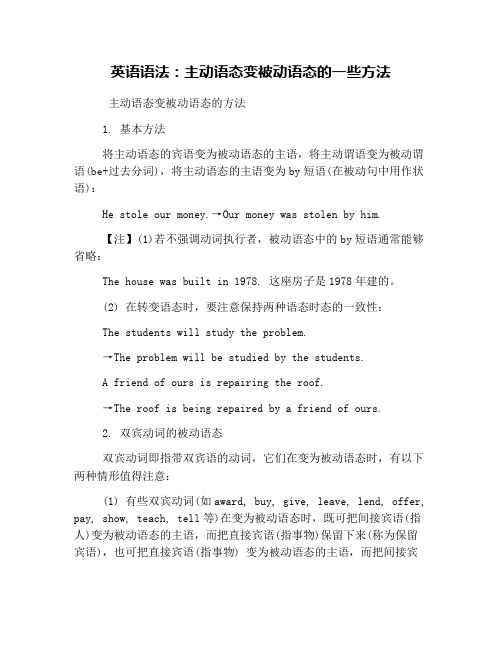
英语语法:主动语态变被动语态的一些方法主动语态变被动语态的方法1. 基本方法将主动语态的宾语变为被动语态的主语,将主动谓语变为被动谓语(be+过去分词),将主动语态的主语变为by短语(在被动句中用作状语):He stole our money.→Our money was stolen by him.【注】(1)若不强调动词执行者,被动语态中的by短语通常能够省略:The house was built in 1978. 这座房子是1978年建的。
(2) 在转变语态时,要注意保持两种语态时态的一致性:The students will study the problem.→The problem will be studied by the students.A friend of ours is repairing the roof.→The roof is being repaired by a friend of ours.2. 双宾动词的被动语态双宾动词即指带双宾语的动词,它们在变为被动语态时,有以下两种情形值得注意:(1) 有些双宾动词(如award, buy, give, leave, lend, offer, pay, show, teach, tell等)在变为被动语态时,既可把间接宾语(指人)变为被动语态的主语,而把直接宾语(指事物)保留下来(称为保留宾语),也可把直接宾语(指事物) 变为被动语态的主语,而把间接宾语改为介词to 或for引起的状语(到底用to还是for,与所搭配的动词相关)。
比较:He gave her some money. 他给她一些钱。
→ She was given some money. / Some money was given to her.He bought her a watch. 他给她买了一快表。
→ A watch was bought for her. / She was bought a watch.(2) 有些双宾动词(如bring, do, make, pass, sell, send, sing, write等)通常用直接宾语(指事物)作被动语态的主语,而将间接宾语用作保留宾语(其前根据情况用介词to或for):Father made me a doll. → A doll was made for me.He wrote her a letter. → A letter was written to her.(3) 有些双宾动词(如answer, deny, envy, refuse, save, spare等)通常用间接宾语(指人)作被动语态的主语,而将直接宾语用作保留宾语:He answered me that question. → I was an swered that question by him.3. 含有情态动词的被动形式若主动语态中谓语含有情态动词,在相对应的被动语态中通常应保留该情态动词,其结构为“情态动词+be(或be的适当时态形式)+过去分词”:Everyone must know this. →This must be known by everyone.请看以下带情态动词被动句实例:This can’t be done in a short time. 这不是短期内能够完成的。
主动语态变被动语态的几种类型

主动语态变被动语态的⼏种类型主动语态变被动语态的⼏种类型⼀、含双宾语的主动结构变为被动结构有些动词,如give,tell,buy等,在句中作谓语时可有两个宾语,⼜称双宾语,即“间接宾语+直接宾语”结构形式。
含双宾语的主动结构变为被动结构时,可以将其中⼀个宾语变为主语,另⼀个保留不动。
⼀般是主动结构的间接宾语变为被动结构的主语。
如果直接宾语变为被动结构的主语,间接宾语之前应加介词to(可省去)或for(⼀般不可省)。
如:1 . My mother gave me a pen.~I was given a pen by my mother.或:A pen was given (to) me by my mother.(介词to 可省略)2 .He told her a long story.~She was told a long story.或:A long story was told (to) her.(介词to可省略)3.Father bought me a new coat.~I was bought a new coat.或:A new coat was bought for me.(介词for不可省略)注意:被动句中强调间接宾语时,其前的介词to 不可省去。
如:This apple is given to me, not to you.这个苹果是给我的,⽽不是给你的。
⼆、含复合宾语的主动结构变为被动结构复合宾语指的是“宾语+宾语补⾜语(简称宾补)”这⼀结构形式。
含复合宾语的主动结构变为被动结构时,只将主动结构中的宾语变为被动结构的主语,宾语补⾜语保留不动。
可充当宾语补⾜语的有名词、动词不定式、现在分词、过去分词、形容词、介词短语等等。
如:1.They call her Xiao Li.(主动结构,宾补为名词Xiao Li )~She is called Xiao LI.(被动结构)2.They chose Tom monitor.(主动结构,宾补为名词monitor)~Tom was chosen monitor.(被动结构)3.He told me to wait for you.(主动结构,宾补为不定式短语to wait for you)~I was told to wait for you.(被动语态)4.I found him lying on the floor.(主动结构,宾补为现在分词短语lying on the floor)~He was found lying on the floor.(被动结构)注意:在主动语态的句⼦中,谓语动词make的宾语补⾜语如果由动词不定式充当,则该动词不定式不带to。
主动语态改被动语态的方法

主动语态改被动语态的方法主动语态改被动语态的方法1)将主动语态改为被动语态应注意以下三个方面:①将主动语态的宾语改为被动语态的主语;②将主动语态的谓语动词改为“be+过去分词”结构;③将主动语态的主语改为介词by之后的宾语,放在谓语动词之后(有时可省略)。
2)含直接宾语和间接宾语的主动语态改为被动语态时有两种情况:①把间接宾语改为被动语态的主语,直接宾语仍保留原位;②把直接宾语改为主动语态的主语,此时,间接宾语前要加介词to或for。
如:He gave the boy an apple.→The boy was given an apple.(或An apple was given to the boy.)Her father bought her a present.→She was bought a present by her father.(或A present was bought for her by her father.)3)不带to的动词不定式作宾语补足语的主动语态,改为被动语态时不定式前要加to。
如:They watched the children sing that morning.→The children were watched to sing that morning.4)带复合宾语的动词在改为被动语态时,一般把主动语态的宾语改为主语,宾语补足语在被动语态中作主语补足语。
如:We call him Xiao Wang.→He is called Xiao Wang.He cut his hair short.→His hair was cut short.They told him to help me.→He was told to help me.5)短语动词是不可分割的整体,改为被动语态时要保持其完整性,介词或副词不可遗漏。
如:We must take good care of the young trees.→The young trees must be taken good care of.6)含有宾语从句的主动结构变为被动结构时,通常用it作为被动结构的先行主语,从句放在句子后面;也可采用另一种形式。
主动语态变被动语态的方法
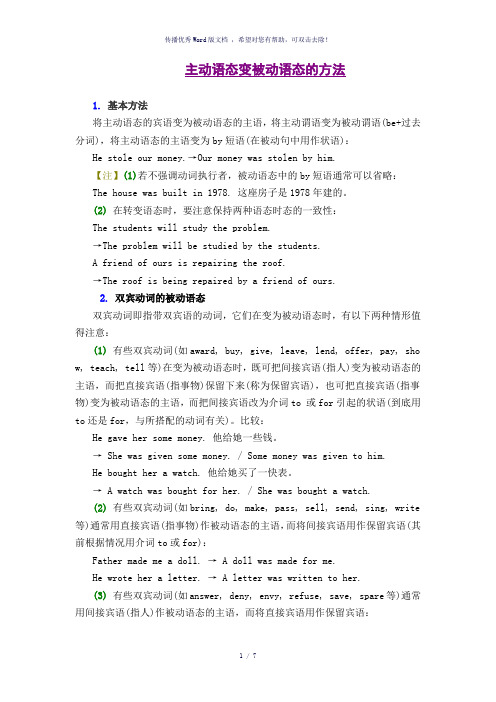
主动语态变被动语态的方法1. 基本方法将主动语态的宾语变为被动语态的主语,将主动谓语变为被动谓语(be+过去分词),将主动语态的主语变为by短语(在被动句中用作状语):He stole our money.→Our money was stolen by him.【注】(1)若不强调动词执行者,被动语态中的by短语通常可以省略:The house was built in 1978. 这座房子是1978年建的。
(2)在转变语态时,要注意保持两种语态时态的一致性:The students will study the problem.→The problem will be studied by the students.A friend of ours is repairing the roof.→The roo f is being repaired by a friend of ours.2. 双宾动词的被动语态双宾动词即指带双宾语的动词,它们在变为被动语态时,有以下两种情形值得注意:(1)有些双宾动词(如award, buy, give, leave, lend, offer, pay, sho w, teach, tell等)在变为被动语态时,既可把间接宾语(指人)变为被动语态的主语,而把直接宾语(指事物)保留下来(称为保留宾语),也可把直接宾语(指事物)变为被动语态的主语,而把间接宾语改为介词to 或for引起的状语(到底用to还是for,与所搭配的动词有关)。
比较:He gave her some money. 他给她一些钱。
→ She was given some money. / Some money was given to him.He bought her a watch. 他给她买了一快表。
→ A watch was bought for he r. / She was bought a watch.(2)有些双宾动词(如bring, do, make, pass, sell, send, sing, write 等)通常用直接宾语(指事物)作被动语态的主语,而将间接宾语用作保留宾语(其前根据情况用介词to或for):Father made me a doll. → A doll was made for me.He wrote her a letter. → A letter was written to her.(3)有些双宾动词(如answer, deny, envy, refuse, save, spare等)通常用间接宾语(指人)作被动语态的主语,而将直接宾语用作保留宾语:He answered me that question. → I was answered that question by him.3. 含有情态动词的被动形式若主动语态中谓语含有情态动词,在相应的被动语态中通常应保留该情态动词,其结构为“情态动词+be(或be的适当时态形式)+过去分词”:Everyone must know this. →This must be known by everyone.请看以下带情态动词被动句实例:This can’t be done in a short time. 这不是短期内可以完成的。
谓语动词用主动表被动的五种情形

一、谓语动词用主动表被动的五种情形(1) 某些连系动词(如look, sound, smell, feel, taste, prove等)要用主动表被动,因为连系动词为不及物动词,它们没有被动语态形式:That dog looks dangerous. 那只狗看起来很危险。
Your idea sounds a good one. 你的想法听起来很好。
My advice proved to be wrong. 我的意见证实是错的。
(2) 当open, close, shut, lock, move等用作不及物动词且表示主语的某种属性时,通常用主动形式表示被动意义:The door won’t shut. 这门关不上。
The supermarket doors shut automatically. 超市的门是自动关的。
- -可修编.【注】该用法的不及物动词通常与can’t, won’t 等连用,注意它与用被动语态含义不同:The window won’t shut. 这窗户关不上。
(说明主语的属性——窗户有问题了)The window won’t be shut. 这窗户将不用关上。
(窗户本身没问题,只是不用关)有时可能用主动和被动形式均可,只是强调重点稍有不同:Suddenly the door opened. 突然门开了。
(不强调动作执行者)The door was suddenly opened. 门突然被打开了。
(强调动作执行者)(3) 当read, wash, clean, cook, cut, wear, carry等用作不及物动词且表示主语的某种属性时,通常要用主动形式表示被动意义:The cloth washes well. 这种布料好洗。
- -可修编.The book sells quickly. 这书销售得快。
This cheese doesn’t cut easily. It’s too soft. 这乳酪不容易切,太软了。
主动语态改为被动语态常见类型
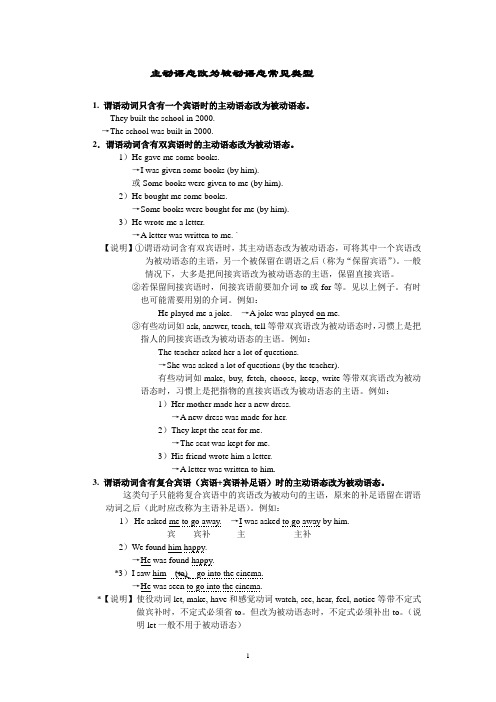
主动语态改为被动语态常见类型1. 谓语动词只含有一个宾语时的主动语态改为被动语态。
They built the school in 2000.→The school was built in 2000.2.谓语动词含有双宾语时的主动语态改为被动语态。
1)He gave me some books.→I was given some books (by him).或Some books were given to me (by him).2)He bought me some books.→Some books were bought for me (by him).3)He wrote me a letter.→A letter was written to me. `【说明】①谓语动词含有双宾语时,其主动语态改为被动语态,可将其中一个宾语改为被动语态的主语,另一个被保留在谓语之后(称为“保留宾语”)。
一般情况下,大多是把间接宾语改为被动语态的主语,保留直接宾语。
②若保留间接宾语时,间接宾语前要加介词to或for等。
见以上例子。
有时也可能需要用别的介词。
例如:He played me a joke. →A joke was played on me.③有些动词如ask, answer, teach, tell等带双宾语改为被动语态时,习惯上是把指人的间接宾语改为被动语态的主语。
例如:The teacher asked her a lot of questions.→She was asked a lot of questions (by the teacher).有些动词如make, buy, fetch, choose, keep, write等带双宾语改为被动语态时,习惯上是把指物的直接宾语改为被动语态的主语。
例如:1)Her mother made her a new dress.→A new dress was made for her.2)They kept the seat for me.→The seat was kept for me.3)His friend wrote him a letter.→A letter was written to him.3. 谓语动词含有复合宾语(宾语+宾语补足语)时的主动语态改为被动语态。
英语中主动表被动的四种类型
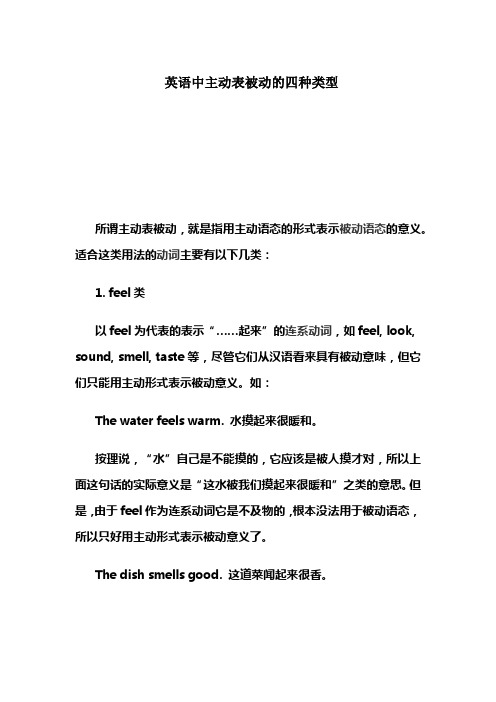
英语中主动表被动的四种类型所谓主动表被动,就是指用主动语态的形式表示被动语态的意义。
适合这类用法的动词主要有以下几类:1. feel类以feel为代表的表示“……起来”的连系动词,如feel, look, sound, smell, taste等,尽管它们从汉语看来具有被动意味,但它们只能用主动形式表示被动意义。
如:The water feels warm. 水摸起来很暖和。
按理说,“水”自己是不能摸的,它应该是被人摸才对,所以上面这句话的实际意义是“这水被我们摸起来很暖和”之类的意思。
但是,由于feel作为连系动词它是不及物的,根本没法用于被动语态,所以只好用主动形式表示被动意义了。
The dish smells good. 这道菜闻起来很香。
同样地,“菜”自己是不能闻的,它应该是被人闻才对,所以上面这句话的实际意义是“这道被我们闻起来很香”之类的意思。
但是,由于smell作为连系动词它是不及物的,根本没法用于被动语态,所以只好用主动形式表示被动意义了。
为什么动词不及物就没法用于被动语态呢?因为由主动语态变为被动语态时,我们要将主动句的宾语变成被动句的主语,如果主动句的谓语是不及物动词,那么它就没有宾语,这样一样,变成被动语态就会没有主语,所以不及物动词没法用于被动语态。
2. open类以open为代表的一类动词,如open, close, shut, lock, move 等,它们既可以用作及物动词,也可以用作不及物动词;当它们用作不及物动词且表示主语的某种属性时,通常用主动形式表示被动意义,此时通常与can't, won't 等连用。
如:It can't move. 它动不了。
The windows wouldn't open. 窗子打不开了。
主动表被动注意这类用法与用被动语态含义的区别。
如:The door won't shut. 这门关不上。
The door won't be shut. 这门将不用关上。
主动变被动语态例句100句
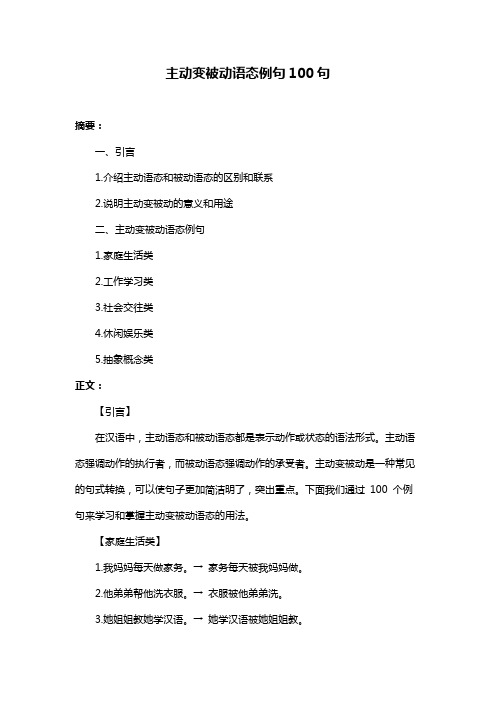
主动变被动语态例句100句摘要:一、引言1.介绍主动语态和被动语态的区别和联系2.说明主动变被动的意义和用途二、主动变被动语态例句1.家庭生活类2.工作学习类3.社会交往类4.休闲娱乐类5.抽象概念类正文:【引言】在汉语中,主动语态和被动语态都是表示动作或状态的语法形式。
主动语态强调动作的执行者,而被动语态强调动作的承受者。
主动变被动是一种常见的句式转换,可以使句子更加简洁明了,突出重点。
下面我们通过100 个例句来学习和掌握主动变被动语态的用法。
【家庭生活类】1.我妈妈每天做家务。
→ 家务每天被我妈妈做。
2.他弟弟帮他洗衣服。
→ 衣服被他弟弟洗。
3.她姐姐教她学汉语。
→ 她学汉语被她姐姐教。
【工作学习类】4.老师给学生讲解难题。
→ 难题被老师讲解。
5.公司给员工提供培训。
→ 培训被公司提供。
6.经理要求员工完成任务。
→ 任务被经理要求完成。
【社会交往类】7.他经常帮助老人过马路。
→ 老人经常被他帮助过马路。
8.政府为百姓提供福利。
→ 福利被政府提供。
9.医生治愈了很多病人。
→ 很多病人被医生治愈。
【休闲娱乐类】10.球迷观看足球比赛。
→ 足球比赛被球迷观看。
11.歌手为观众演唱歌曲。
→ 歌曲被歌手演唱。
12.电影导演执导了一部好电影。
→ 电影被导演执导。
【抽象概念类】13.谣言被传播开来。
14.智慧被人们所推崇。
15.幸福被追求和珍惜。
通过以上例句,我们可以看到主动变被动语态的用法和特点。
主动语态改为被动语态常见类型

主动语态改为被动语态常见类型1. 谓语动词只含有一个宾语时的主动语态改为被动语态。
They built the school in 2000.→The school was built in 2000.2.谓语动词含有双宾语时的主动语态改为被动语态。
1)He gave me some books.→I was given some books (by him).或Some books were given to me (by him).2)He bought me some books.→Some books were bought for me (by him).3)He wrote me a letter.→A letter was written to me. `【说明】①谓语动词含有双宾语时,其主动语态改为被动语态,可将其中一个宾语改为被动语态的主语,另一个被保留在谓语之后(称为“保留宾语”)。
一般情况下,大多是把间接宾语改为被动语态的主语,保留直接宾语。
②若保留间接宾语时,间接宾语前要加介词to或for等。
见以上例子。
有时也可能需要用别的介词。
例如:He played me a joke. →A joke was played on me.③有些动词如ask, answer, teach, tell等带双宾语改为被动语态时,习惯上是把指人的间接宾语改为被动语态的主语。
例如:The teacher asked her a lot of questions.→She was asked a lot of questions (by the teacher).有些动词如make, buy, fetch, choose, keep, write等带双宾语改为被动语态时,习惯上是把指物的直接宾语改为被动语态的主语。
例如:1)Her mother made her a new dress.→A new dress was made for her.2)They kept the seat for me.→The seat was kept for me.3)His friend wrote him a letter.→A letter was written to him.3. 谓语动词含有复合宾语(宾语+宾语补足语)时的主动语态改为被动语态。
句型变换改变主动语态为被动语态
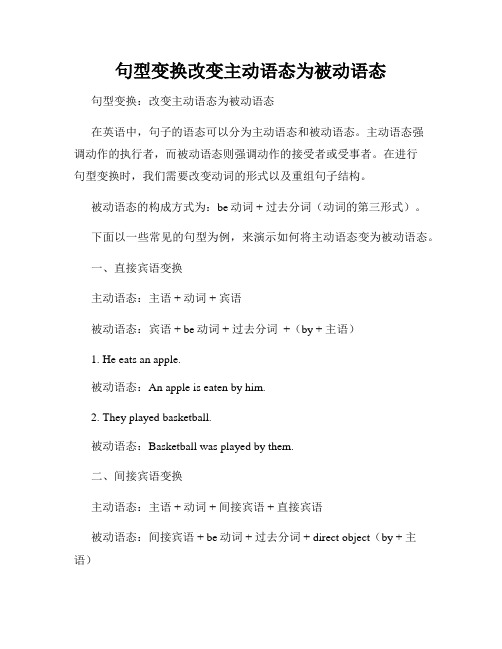
句型变换改变主动语态为被动语态句型变换:改变主动语态为被动语态在英语中,句子的语态可以分为主动语态和被动语态。
主动语态强调动作的执行者,而被动语态则强调动作的接受者或受事者。
在进行句型变换时,我们需要改变动词的形式以及重组句子结构。
被动语态的构成方式为:be动词 + 过去分词(动词的第三形式)。
下面以一些常见的句型为例,来演示如何将主动语态变为被动语态。
一、直接宾语变换主动语态:主语 + 动词 + 宾语被动语态:宾语 + be动词 + 过去分词 +(by + 主语)1. He eats an apple.被动语态:An apple is eaten by him.2. They played basketball.被动语态:Basketball was played by them.二、间接宾语变换主动语态:主语 + 动词 + 间接宾语 + 直接宾语被动语态:间接宾语 + be动词 + 过去分词 + direct object(by + 主语)1. She gave me a book.被动语态:I was given a book by her.2. They showed us the way.被动语态:We were shown the way by them.三、不带宾语的及物动词变换主动语态:主语 + 不及物动词被动语态:be动词 + 过去分词 +(by + 主语)1. He sleeps.被动语态:He is slept.2. The flowers bloom.被动语态:The flowers are bloomed.四、双宾语变换主动语态:主语 + 动词 + 间接宾语 + 直接宾语被动语态:间接宾语 + be动词 + 过去分词 + direct object(by + 主语)1. She gave me a present.被动语态:I was given a present by her.2. He showed them the pictures.被动语态:They were shown the pictures by him.需要注意的是,在被动语态中,如果句子中有by短语,该短语通常用于表示动作的执行者或者强调执行者的重要性。
句子大全之英语句子主动变被动语态多种情况例析

英语句子主动变被动语态的多种状况例析中国人思想的着眼点在动作的施动者,英佳人思想的着眼点在动作的蒙受者。
中国人常这样说:i expect you to be there on time. 我希望你准时到那边。
英佳人常这样说:you are expected to be thereon time. 希望你准时到那边。
这就是英语中被动语态的使用比汉语中多的原由。
因为英语句子的主动语态构造不一样,因此变为被动语态的方式也各不同样,总结起来主要有几方面。
一、主语+谓语+宾语“主语+谓语+宾语〞构造中只有一个宾语,变为被动语态时,将宾语变为主语。
如:they will discuss the plan at the meeting. 他们将在会议上议论这个问题。
——the plan will be discussed at the meeting. 这个问题将在会议上议论。
二、主语+谓语+间接宾语+直接宾语在这个句型中,谓语动词后有两个宾语。
变为被动语态时,一般将往常指人的间接宾语转变为主语,但有时也可将指物的间接宾语转变成主语。
如:we gave the student some books. 我们给了这个学生几本书。
——the student was given some books. 这个学生被给了几本书。
注意:用直接宾语作被动语态的主语时,往常要在间接宾语前加上合适的介词(如to,for,of 等),以增强间接宾语的语气。
the host had caught us some fish. 主人给我们捉了一些鱼。
——some fish had been caught for us by the host. 主人给我们捉了一些鱼。
(for 不行省)三、主语+谓语+宾语+宾语补足语在这个句型中,谓语动词后有一个宾语和一个宾语补足语,变为被动语态时,宾语转变为主语,宾语补足语也随之变为主语补足语。
如:all the villagers painted the houses white. 全部村民都把房屋涂成了白色。
主动语态变为被动语态的易错情况(专练及答案)
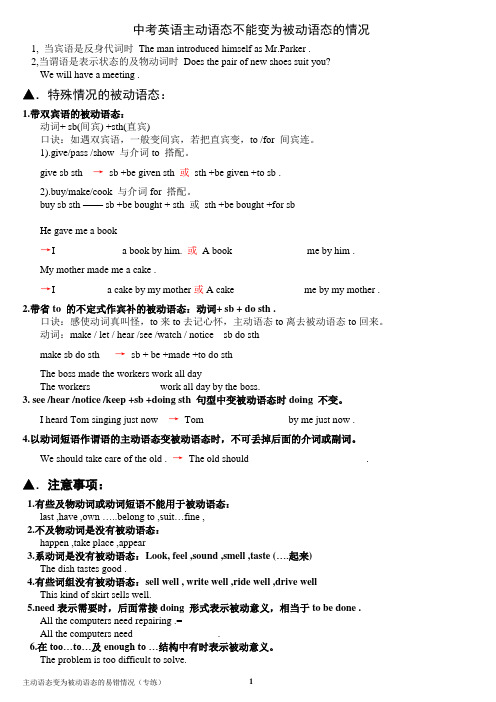
中考英语主动语态不能变为被动语态的情况1, 当宾语是反身代词时The man introduced himself as Mr.Parker .2,当谓语是表示状态的及物动词时Does the pair of new shoes suit you?We will have a meeting .▲.特殊情况的被动语态:1.带双宾语的被动语态:动词+ sb(间宾) +sth(直宾)口诀:如遇双宾语,一般变间宾,若把直宾变,to /for 间宾连。
1).give/pass /show 与介词to 搭配。
give sb sth →sb +be given sth 或sth +be given +to sb .2).buy/make/cook 与介词for 搭配。
buy sb sth —— sb +be bought + sth 或sth +be bought +for sbHe gave me a book→I ______ ______ a book by him. 或 A book ____ ____ _____ me by him .My mother made me a cake .→I ____ _____ a cake by my mother或A cake ____ ____ ____ me by my mother .2.带省to 的不定式作宾补的被动语态:动词+ sb + do sth .口诀:感使动词真叫怪,to来to去记心怀,主动语态to离去被动语态to回来。
动词:make / let / hear /see /watch / notice sb do sthmake sb do sth →sb + be +made +to do sthThe boss made the workers work all dayThe workers ____ ____ ____ work all day by the boss.3. see /hear /notice /keep +sb +doing sth 句型中变被动语态时doing 不变。
被动语态

被动语态在教学过程中,我发现许多学生对被动语态这个知识点掌握得都不够好,特别是被动语态的一些特例的运用。
在此,我归纳了一下主动语态变被动语态的几种特殊形式。
要运用被动语态,首先要明确被动语态的构成。
被动语态是由“助动词be+及物动词的过去分词”构成,助动词be有人称和时态的变化。
主动语态变被动语态的几种特殊形式:1. 带双宾语的谓语动词变为被动语态谓语动词带双宾语时,既可以将间接宾语转化成主语,也可将直接宾语转化成主语。
若将直接宾语转化成主语,则在间接宾语前加上介词to或for。
eg: I bought her a book.→She was bought a book by me.(间接宾语改为主语)→ A book was bought for her by me. (直接宾语改为主语)2. 短语动词变为被动语态许多由不及物动词构成的短语动词,相当于及物动词,可以有宾语,也可以有被动语态。
必须注意:短语动词是一个不可分割的整体,在变为被动语态时,不可丢掉构成短语动词的介词或副词。
eg: We should speak to the old politely.→The old should be spoken to politely.(介词 to不可省略)3. 带复合宾语的动词变为被动语态宾语加上宾语补足语一起构成复合宾语,变被动语态时,只把宾语变为被动句的主语,宾语补足语保留在原处,成为主语补足语。
eg: I heard Mary singing in her room.→Mary was heard singing in her room.4. 被动语态后动词的选择主动句中在感官动词see、hear、watch、notice、feel等及使役动词have、let、make动词后跟省略to的不定式,变为被动句时,应加上不定式符号to。
eg: He often makes the little boy cry.→The little boy is often made to cry by him.I saw Tom play basketball on the playground yesterday afternoon.→Tom was seen to play basketball on the playground yesterday afternoon.助记口决:四看(look at、notice、see、watch)三使(have、let、make)二听(hear、listen to)一感(feel)半帮助(help)。
主动句变被动句的几种特殊类型

主动句变被动句的几种特殊类型(1)主动语态中有些感官动词(如:hear, see, watch, notice等)后用不带to的不定式作宾语补足语,变为被动语态时,要把不定式符号to还原,即:hear(see) sb. do sth.→sb. be heard(seen) to do sth.。
We often hear the girl sing in her room in the evening.→The girl is often heard to sing in her room in the evening by us.晚上我们经常听到那个女孩在她的房间里唱歌。
(2)主动语态中有些使役动词(如:make, let等)后用不带to的不定式作宾语补足语,变为被动语态时,同样要把不定式符号to还原,即:make sb. do sth.→sb. be made to do sth.。
主动结构表示被动意义的情况:(1)动词open, read, sell, write等作不及物动词, 且它们的主语为物时。
如:The pen writes well. 这支钢笔很好用。
(2)某些连系动词(如smell, look, taste, feel, sound等)描述某物特性时。
如:This kind of flower smells sweet. 这种花闻起来很香。
(3)一些动词的主动形式表被动意义。
①be worth doing中,doing表示被动意义。
如:This movie is worth watching. 这部电影值得一看。
②“need/require+doing”相当于“need/require+to be done”, to be done 是不定式的被动结构。
如:Your car needs washing.= Your car needs tobe washed. 你的汽车该洗了。
主动语态变被动语态的几个特例
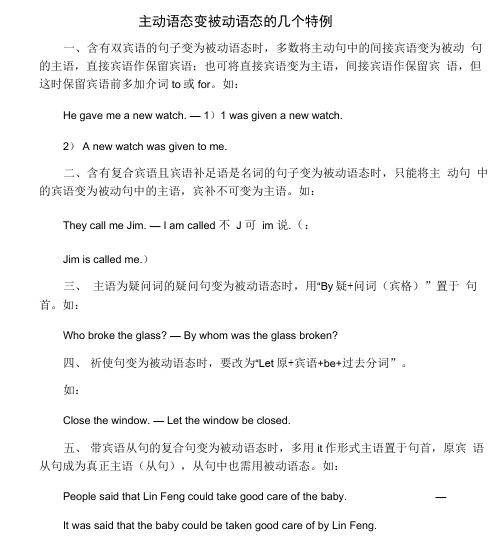
主动语态变被动语态的几个特例一、含有双宾语的句子变为被动语态时,多数将主动句中的间接宾语变为被动句的主语,直接宾语作保留宾语;也可将直接宾语变为主语,间接宾语作保留宾语,但这时保留宾语前多加介词to或for。
如:He gave me a new watch. — 1)1 was given a new watch.2) A new watch was given to me.二、含有复合宾语且宾语补足语是名词的句子变为被动语态时,只能将主动句中的宾语变为被动句中的主语,宾补不可变为主语。
如:They call me Jim. — I am called 不J 可im 说.(:Jim is called me.)三、主语为疑问词的疑问句变为被动语态时,用“By疑+问词(宾格)”置于句首。
如:Who broke the glass? — By whom was the glass broken?四、祈使句变为被动语态时,要改为“Let原+宾语+be+过去分词”。
如:Close the window. — Let the window be closed.五、带宾语从句的复合句变为被动语态时,多用it作形式主语置于句首,原宾语从句成为真正主语(从句),从句中也需用被动语态。
如:People said that Lin Feng could take good care of the baby. —It was said that the baby could be taken good care of by Lin Feng.六、含有谓语动词know的主动句变为被动语态时,不用by短语,需by改为to。
如:1 /10七、no one、nobody等否定代词作主语的句子变为被动语态时,谓语动词用否定式,不再用原主语'但可加上byanyone、byanybody等短语。
如:No one can lift the heavy box. — The heavy box can not be lifted (by anyone).被动语态改错练习下列每句均有错误,请改正:1. The May 4 Movement (运动)was happened in19.2. Who was my book taken away?3. Was this room cleaned by you and he?4. When did the sweater bought?5. She was made sing a second song.(sing前加to (在make, hear, see, watch, feel等动词后作宾补的不定式不加to °但这些动词构成的被动句中,不定式符号to必须加上。
语态的转换正确转换句子的主动和被动语态
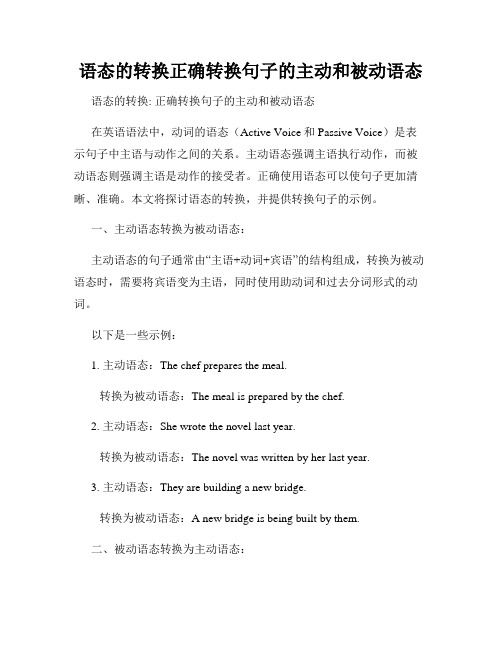
语态的转换正确转换句子的主动和被动语态语态的转换: 正确转换句子的主动和被动语态在英语语法中,动词的语态(Active Voice和Passive Voice)是表示句子中主语与动作之间的关系。
主动语态强调主语执行动作,而被动语态则强调主语是动作的接受者。
正确使用语态可以使句子更加清晰、准确。
本文将探讨语态的转换,并提供转换句子的示例。
一、主动语态转换为被动语态:主动语态的句子通常由“主语+动词+宾语”的结构组成,转换为被动语态时,需要将宾语变为主语,同时使用助动词和过去分词形式的动词。
以下是一些示例:1. 主动语态:The chef prepares the meal.转换为被动语态:The meal is prepared by the chef.2. 主动语态:She wrote the novel last year.转换为被动语态:The novel was written by her last year.3. 主动语态:They are building a new bridge.转换为被动语态:A new bridge is being built by them.二、被动语态转换为主动语态:被动语态的句子通常由“主语+助动词+被动形式的动词+其他成分”组成,转换为主动语态时,需要将被动形式的动词还原为主动形式,并重新调整句子结构。
以下是一些示例:1. 被动语态:The cake was eaten by them.转换为主动语态:They ate the cake.2. 被动语态:The homework is being done by the students.转换为主动语态:The students are doing the homework.3. 被动语态:The book was written by a famous author.转换为主动语态:A famous author wrote the book.三、需要注意的事项:1. 当主动句中的宾语是代词时,在被动语态转换中,宾语变为主语时需要使用适当的代词形式。
语法知识点回顾主动语态与被动语态的转换
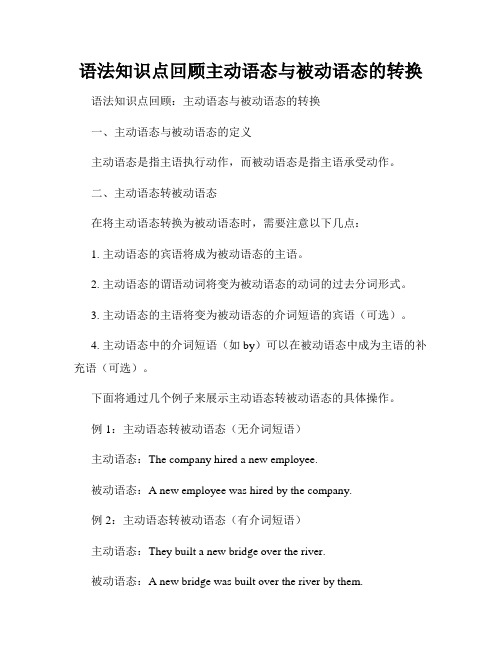
语法知识点回顾主动语态与被动语态的转换语法知识点回顾:主动语态与被动语态的转换一、主动语态与被动语态的定义主动语态是指主语执行动作,而被动语态是指主语承受动作。
二、主动语态转被动语态在将主动语态转换为被动语态时,需要注意以下几点:1. 主动语态的宾语将成为被动语态的主语。
2. 主动语态的谓语动词将变为被动语态的动词的过去分词形式。
3. 主动语态的主语将变为被动语态的介词短语的宾语(可选)。
4. 主动语态中的介词短语(如by)可以在被动语态中成为主语的补充语(可选)。
下面将通过几个例子来展示主动语态转被动语态的具体操作。
例1:主动语态转被动语态(无介词短语)主动语态:The company hired a new employee.被动语态:A new employee was hired by the company.例2:主动语态转被动语态(有介词短语)主动语态:They built a new bridge over the river.被动语态:A new bridge was built over the river by them.例3:主动语态转被动语态(有介词短语作宾语补充语)主动语态:He gave a book to her.被动语态:A book was given to her by him.三、被动语态转主动语态在将被动语态转换为主动语态时,需要注意以下几点:1. 被动语态的主语将成为主动语态的宾语。
2. 被动语态的动词的过去分词形式将变为主动语态的谓语动词。
3. 被动语态的介词短语(如果存在)将成为主动语态中介词的宾语(可选)。
下面将通过几个例子来展示被动语态转主动语态的具体操作。
例4:被动语态转主动语态(无介词短语)被动语态:A new car was bought by her.主动语态:She bought a new car.例5:被动语态转主动语态(有介词短语)被动语态:The letter was sent by him to Mary.主动语态:He sent the letter to Mary.例6:被动语态转主动语态(有介词短语作介词的宾语)被动语态:A song was sung by her at the party.主动语态:She sang a song at the party.通过以上例子,我们可以看出如何将主动语态转换为被动语态,并将被动语态转换为主动语态。
- 1、下载文档前请自行甄别文档内容的完整性,平台不提供额外的编辑、内容补充、找答案等附加服务。
- 2、"仅部分预览"的文档,不可在线预览部分如存在完整性等问题,可反馈申请退款(可完整预览的文档不适用该条件!)。
- 3、如文档侵犯您的权益,请联系客服反馈,我们会尽快为您处理(人工客服工作时间:9:00-18:30)。
主动语态变被动语态的几个特例一、含有双宾语的句子变为被动语态时,多数将主动句中的间接宾语变为被动句的主语,直接宾语作保留宾语;也可将直接宾语变为主语,间接宾语作保留宾语,但这时保留宾语前多加介词to或for。
如:He gave me a new watch.→1) I was given a new watch.2) A new watch was given to me.二、含有复合宾语且宾语补足语是名词的句子变为被动语态时,只能将主动句中的宾语变为被动句中的主语,宾补不可变为主语。
如:They call me Jim. →I am called Jim.(不可说:Jim is called me.)三、主语为疑问词的疑问句变为被动语态时,用“By+疑问词(宾格)”置于句首。
如:Who broke the glass? →By whom was the glass broken?四、祈使句变为被动语态时,要改为“Let +原宾语+be+过去分词”。
如:Close the window. →Let the window be closed.五、带宾语从句的复合句变为被动语态时,多用it作形式主语置于句首,原宾语从句成为真正主语(从句),从句中也需用被动语态。
如:People said that Lin Feng could take good care of the baby. →It was said that the baby could be taken good care of by Lin Feng.六、含有谓语动词know的主动句变为被动语态时,不用by短语,需by改为to。
如:We all know the scientist. →The scientist is known to us all.七、no one、nobody等否定代词作主语的句子变为被动语态时,谓语动词用否定式,不再用原主语,但可加上by anyone、by anybody等短语。
如:No one can lift the heavy box. →The heavy box can not be lifted (by anyone).被动语态改错练习下列每句均有错误,请改正:1. The May 4 Movement(运动) was happened in 1919.2. Who was my book taken away?3. Was this room cleaned by you and he?4. When did the sweater bought?5. She was made sing a second song.( sing 前加to(在make, hear, see, watch, feel等动词后作宾补的不定式不加to 。
但这些动词构成的被动句中,不定式符号to 必须加上。
)6. The poor man was saved and gave some money.7. A science lab is built now.8. I was given by Li Ping two books.9. A happy life is being lived by us.10. Something must be did to finish the work on time.答案: 1. was happened →happened 2. 句末加by或将原句改为By whom was my book taken away? 3. he→him 4. did→was 5. sing 前加to(在make, hear, see, watch, feel等动词后作宾补的不定式不加to 。
但这些动词构成的被动句中,不定式符号to 必须加上。
6. gave→given 此句意为“有人救了那个可怜的人,并给了他一点钱”,因此后一个动词也要用被动语态。
7.is built→is being built 由now判断,应用现在进行时的被动语态。
8.by Li Ping two books →two books by Li Ping . by短语一般置于被动谓语结构之后,但在含双宾语的主动句变为被动句时,by短语应置于另一保留宾语之后。
9.原句改为:We are living a happy life. 主动句宾语为同源宾语时,不可改为被动句。
10.did→done 被动谓语结构中的行为动词都有过去分词,而不是过去式。
主动语态变为被动语态的方法一、简单句的主动语态变被动语态(1) 通常的办法是:将主动结构中的宾语变为被动结构中的主语,将主动结构中的谓语动词变为“be / get +过去分词”形式,将主动结构中的主语变为介词by的宾语(若动作的执行者没有必要说明则可以省略该by短语)。
如:Li Lei planted the tree last year. →The tree was planted by Li Lei last year. 这棵树是李蕾去年栽的。
Workers made the machines in Changsha. →The machines were made in Changsha. 这些机器是长沙造的。
(2) 将含有宾语补足语的句子变为被动语态时,应将宾语变为被动结构的主语,而宾语的补足语则留在原处成为主语补足语。
如:He painted the door green yesterday. →The door was painted green yesterday. 昨天门被漆成绿色了。
注意:表示“使、让”的动词make, have等,以及感官动词see, watch, observe, feel, hear, listen to, look at等,在主动语态中,接不定式做宾语补足语时,不定式前的to 要省略,而变为被动语态时,成为主语补足语的不定式,则必须带to。
如:I saw him go into the teachers’office. →He was seen to go into the teachers’office. 看见他进入了教师办公室。
(3) 带双宾语的句子变为被动语态时,既可将直接宾语变为被动语态的主语,而在间接宾语前加to 或for留在动词之后;也可将间接宾语变为被动结构的主语,而直接宾语留在动词之后。
但一般采用后一种用法。
He gave me the pen last year. →I was given the pen last year. / The pen was given to me last year. 这支笔是去年给我的。
【说明】一般说来,间接宾语前带to的动词有:bring, give, hand, lend, offer, pass, post, send, show, take, teach, tell, write, throw等;间接宾语前带for的动词有:book登记, buy, call,get, make, do等。
(4) 动词believe, consider考虑, declare声明, expect, know, report, say, suppose, think等的被动语态,常有两种结构形式。
如:He was said to get hurt in the car accident. 人们说他在车祸中受伤了。
It was said that he got hurt in the car accident. 人们说他在车祸中受伤了。
(5) 短语动词变被动语态时,短语动词后面的介词或副词不能省略。
如:She has never been operated on before. 她从未动过手术The baby was looked after by her sister. 这婴儿由她的姐姐照顾。
His plan was laughed at by everyone. 他的计划大家都嘲笑。
二、复合句的主动语态变被动语态复合句的主动语态变被动语态时,复合句中的主句和从句都须同时变为被动语态。
如:Li Lei told us that the teacher praised him today. →We were told that Li Lei was praised by the teacher today. 有人告诉我们说今天李蕾受到了老师的表扬。
主动语态变被动语态的易错点含有双宾语的主动句变被动句时,可分别将其中的一个宾语变为主语,另一个不动,但变间接宾语为主语的情况较多。
主动:Tom gave me a present on my birthday. 我生日那天汤姆送我一件礼物。
被动:I was given a present by Tom on my birthday. A present was given to me yesterday.■注意:如果把直接宾语(指物)改为主语,则在间接宾语(指人)前加适当的介词。
1. 在下列动词后,通常在间接宾语前用介词to:bring, give, hand, lend, offer, pass, sell, show, take,通tell等。
2. 在下列动词后,一般在间接宾语前用介词for:build, buy, cook, cut, choose, do, fetch, find, fix, get, keep, make, order, paint, play, sing等。
主动:Mother made me a new skirt. 母亲给我做了件衬衣。
被动:A new skirt was made for me.3. 由于某些动词与介词有习惯搭配,既不用to也不用for, 而用别的介词。
如:People all over the world know the Great Wall. 世界上的人都知道长城。
The Great Wall is known to people all over the world. (不用by短语)4. 有时用间接宾语作主语讲不通或不习惯,必须用直接宾语作主语。
如:Tom wrote me a letter.误:I was written a letter by Tom.正:A letter was written to me by Tom.类似的动词还有:return, send, pass, hand, sell, teach等。
■含复合宾语(宾语+宾补)的主动句改为被动句时,一般把主动句中的宾语改为主语,而宾语补足语保留在谓语动词后面成为主语补足语。
